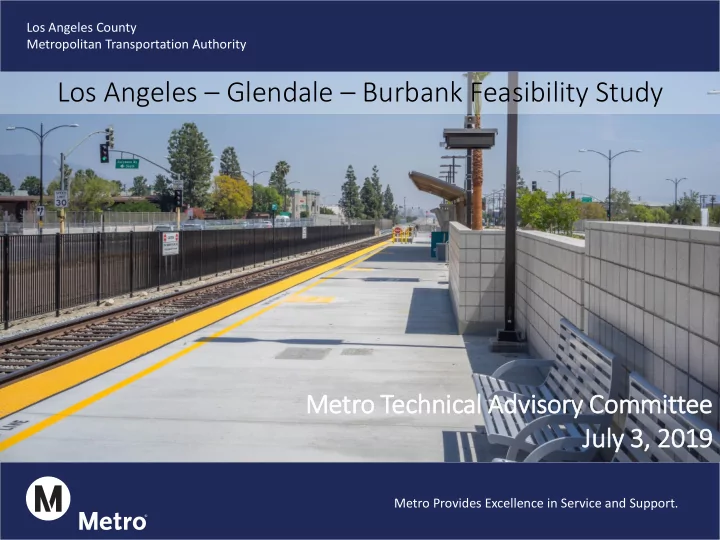

Los Angeles County Metropolitan Transportation Authority Los Angeles – Glendale – Burbank Feasibility Study Metro Technic ical l Advi visory ry Commit ittee Ju July ly 3, , 2019 Metro Provides Excellence in Service and Support.
Metro Board Motion At the October 2016 Board meeting, the Metro Board of Directors directed staff to conduct a study to evaluate: 1. Up to two new rail stations in the City of Glendale and up to two new rail stations in the City of Los Angeles; 2. Increased passenger rail service from Union Station to the City of Burbank; and 3. Opportunities for increased access to Source: Ron Reiring, Flickr 2007 the regional transit network in the City of Glendale 2
Purpose of the Study a) Identify opportunities to add more frequent rail service to better serve the communities and reduce traffic congestion on the freeway and local streets b) Address recent growth in population and employment in the corridor c) Provide alternative to the congested I-5 corridor 3
1. Assess Potential Station Locations 1. Evaluated corridor from LAUS to Burbank Airport North Station 2. Goal was to identify up to two station sites in the City of Los Angeles and up to two station sites in the City of Glendale 3. Five station sites were initially identified and evaluated 4. Station locations were discussed with the Corridor Cities Working Group and through a public outreach survey which received over 2,500 respondents 5. Stakeholders and analysis confirmed that the River Park and Grandview/Sonora station locations should be examined further 4
2. Evaluate Rail Service by Mode Locomotive Haul Coaches Rail Multiple Unit (RMU) Light Rail Transit (LRT) (LHC) e.g. Metrolink Trains e.g. Metro Gold Line e.g. Redlands Passenger Rail Project (SBCTA) Shared track with freight and Shared track with freight and LHC Two dedicated tracks Corridor Operations DMU (FRA compliant) (FRA compliant) (non-FRA compliant) Speed (avg speed with stops 36 / 79 mph 40 / 79 mph 24 / 65 mph and max corridor speed) Average Station Spacing 5 miles 1 – 4 miles 1 mile Low (New locomotive at $7M; Medium (New vehicles at $10- High (New corridor and Level of Investment new passenger car at $2M $15M/vehicle; new MS at $30- vehicles needed at $250M+ corridor upgrades TBD) $50M; corridor upgrades TBD) per mile) $290M – Redlands Passenger Rail $2.3B – Gold Line Extension Similar Project Costs Project Phase 2b to Pomona 840 sitting 450 sitting and standing 405 sitting and standing Max. Passenger Capacity (six-car sets) (three-car sets) (three-car sets) 5
3. Evaluate Increases to Passenger Rail Service 1. Metrolink Scenarios studied in increments: a) M Option 1: Add one evening round trip b) M Option 2: Add two new stations c) M Option 60M: 60-minute bi-directional service d) M Option 30M: 30-minute bi-directional service e) M Option 15M: 15-minute bi-directional service 2. RMU Option: a) 15-minute bi-directional Blended Metrolink and RMU service to Via Princessa 3. LRT Scenarios studied different corridors: a) LRT Option 1: Parallel to Metrolink from LAUS to Burbank Airport North b) LRT Option 2: LAUS to Downtown Glendale, Downtown Burbank to Burbank Airport North 6
Study Results 1. The Metrolink 30-min option can be achieved in phases. LRT options require substantial capital/operating funds up front. a) Between Los Angeles and Burbank, less than 30-minute headways can be achieved when combined with existing Ventura County Line and Amtrak services under this scenario b) Interim improvements for the short-term (5-years) include an additional evening round trip, additional midday round trip, and reaching 60-minute off-peak/30-minute peak service on the AVL c) If funding is identified, 30-minute bi-directional service can be achieved in 10-years 2. Based on the stakeholder survey, participants noted a preference for more express service for longer commutes 3. Increasing service on the corridor can be accomplished at lower operational costs without impacting other passenger and freight rail services within the corridor a) This can also be tested with a RMU pilot program to identify O&M cost saving opportunities 7
Questions 8 Photo: Charles Freericks
Recommend
More recommend